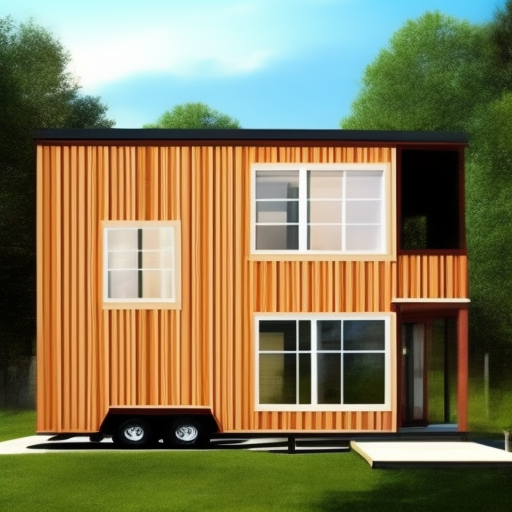In our era of ever-escalating real estate prices, one may wonder if there is still a way to afford to own a home without breaking the bank? The answer is yes! Tiny homes offer the solution of minimalist living, an economical lifestyle choice that has gained significant traction in recent years. This article takes a closer look into tiny homes and what makes investing in economical design an attractive option.
Advantages of Tiny Homes
Small houses have become a trendy housing alternative over the years. While tiny homes are often praised for their aesthetics, many people don’t realize the practical advantages that come with downsizing. Here are some :
- Cost-effective: When it comes to tiny homes, small means savings. A tiny home is a fraction of the cost of a conventional home. For example, a tiny home can range from $20,000 to $100,000, while the average price for a conventional home is $300,000. Moreover, tiny homes have lower energy bills and require less maintenance.
- Minimalistic Living: Tiny homes promote simple living, giving the homeowner an opportunity to downsize and get rid of excess items, leading to a more organized, stress-free life. In a society consumed with consumerism, tiny homes are an excellent way to embrace a minimalist lifestyle, which is better for the environment and our mental health. Additionally, it’s easier to clean a tiny home due to limited square footage.
If you want to live a minimalistic lifestyle, reduce your carbon footprint, and save money, tiny homes are an excellent option. A tiny house makes it possible for anyone to own a comfortable and stylish home without breaking the bank. Not to mention, it’s also an excellent opportunity to customize your home and make it suit your unique style and wants without worrying about space constraints.
Design Strategies for Tiny Homes
When designing a tiny home, every inch counts. But that doesn’t mean you have to compromise on style or functionality. There are many design strategies you can implement to make the most of your limited space. Here are a few:
Maximize vertical space: Utilize your walls by installing shelving units, hooks, or hanging storage. Even a small wall-mounted bookshelf can add a lot of storage space.
Multi-functional furniture: Choose furniture that can serve multiple purposes. For example, a sofa bed can double as a guest bed, a storage ottoman can provide seating and storage, and a coffee table with lift-top storage is perfect for small spaces.
Natural light: Adding natural light to your tiny home can make it feel more spacious. Consider installing skylights or large windows to bring in more natural light. To maximize privacy, you can add frosted glass, wooden blinds or sheer curtains.
Financial Benefits of Investing in a Tiny Home
When it comes to owning a tiny home, there are plenty of financial benefits that come along with it. Investing in a tiny home can not only save you money but also provide you with security and flexibility. Let’s dive into some of the .
- Affordable upfront costs: Typically, the cost of building a tiny home is significantly less than a traditional home. You can build a tiny home with just a fraction of the cost of a regular house. This means that your upfront costs will be reduced, and you can save a lot of money in the long run.
- Lower utility bills: Tiny homes tend to use less energy than regular houses, which can reduce your utility bills. When you have a smaller space to heat, cool and light, you’ll end up paying less on electricity bills.
- Reduced maintenance costs: Tiny homes are a lot easier to maintain than regular homes. With fewer rooms and less space to clean, tiny homeowners can have a more accessible and cheaper cleaning routine.
Overall, owning a tiny home can help you save money in many ways. From reduced upfront costs to lower utility bills and maintenance, tiny homes provide a cost-effective solution. By investing in a tiny home, you’ll have more flexibility in your finances and can save money for other things like travel, hobbies, and retirement.
Finding the Right Tiny Home for You
When it comes to finding the right tiny home, there are a few things to consider before taking the leap. You’ll want to think about your lifestyle, how much space you really need, and what you’re willing to compromise on. For example, if you love cooking and entertaining, you may not want to sacrifice a full-sized kitchen. On the other hand, if you’re an avid traveler who plans to be on the road frequently, you might prioritize mobility over square footage.
One thing that’s important to keep in mind is that there’s no one-size-fits-all solution when it comes to tiny homes. Some people prefer a minimalist approach with only the bare necessities, while others want all the comforts of home packed into a compact space. To help you get inspired and find what works for you, browse through photos of different styles and layouts to get a sense of what resonates. Whether you’re drawn to a sleek modern design or a cozy cabin aesthetic, there are plenty of options out there to make your tiny home dreams a reality. Tiny homes present a unique opportunity to experience life on your own terms. Their economical design and affordability make them an attractive choice in today’s real estate market. For those looking to live a minimalist lifestyle or practice mindful consumption, tiny homes offer a creative solution. Everyone’s lifestyle and budget preferences are different, and tiny homes could be the right fit for those who are looking for a smaller, affordable home.